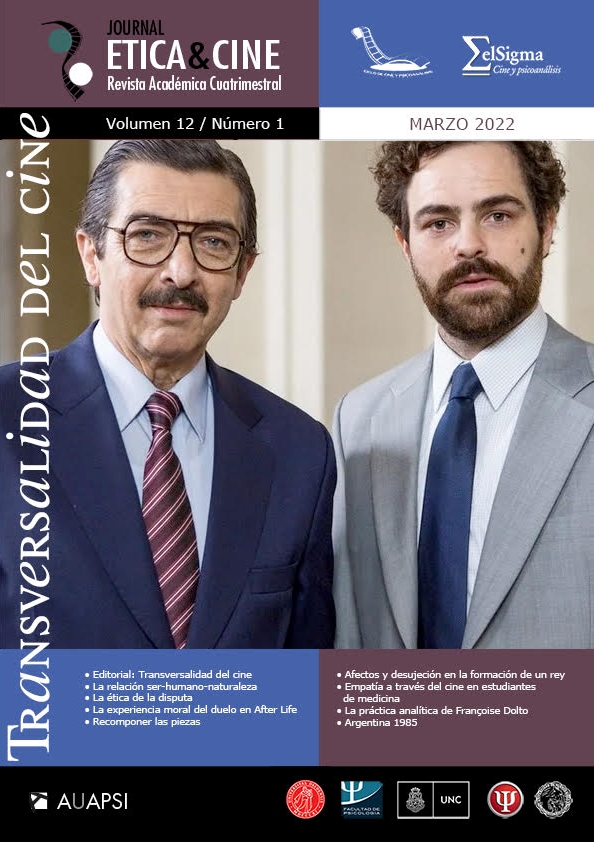La relación ser-humano-naturaleza en el largometraje de Hayao Miyazaki: Nausicaä del Valle del Viento, desde el principio de armonía confuciano
DOI:
https://doi.org/10.31056/2250.5415.v12.n1.37377Palabras clave:
virtud, armonía, naturaleza, ser humano, éticaResumen
El presente trabajo propone una lectura de la relación ser humano-naturaleza en el largometraje desarrollado por el director japonés Hayao Miyazaki: Nausicaä del Valle del Viento, a través del principio confuciano de armonía, ampliando la forma en que se ha comprendido el papel del agente moral en la obra de Miyazaki en su relación con la naturaleza.
Referencias
Ames, R. (2011). Confucian Role Ethics. A Vocabulary. Hong Kong: The Chinese University of Hong Kong.
Bigelow, S. (2009). Technologies of Perception: Miyazaki in Theory and Practice. Animation: an interdisciplinary journal, 4 (1), pp. 55-75, DOI: 10.1177/1746847708099740.
Bloomsbury, New York, pp. 93-108. ISBN 9781628923513. The ecological and consumption themes of the films of Hayao Miyazaki. Ecological Economics, 54, pp. 1-7.
Carbullido, S. (2008). Spirituality, Aesthetics, and Aware: Feeling Shinto in Miyazaki Hayao’s My Neighbour Totoro. Tesis para optar por el grado de Maestría en Artes. Department of Pacific and Asian Studies. University of Victoria.
Cardona, F. y Martín, M. (1968). Confucio. Los cuatro libros clásicos. Barcelona: Editorial Bruguera S.A.
Cavallaro, D. (2006). The Animé Art of Hayao Miyazaki. North Caroline: McFarland & Company, Inc., Publishers.
Cavallaro, D. (2015). Hayao Miyazaki’s World Picture. North Caroline: McFarland & Company, Inc., Publishers.
Chan, M. (2015). Environmentalism and The Animated Landscape in Nausicaä of the Valley of the Wind (1984) and Princess Mononoke (1997). En: Pallant, C. (Ed). Animated Landscapes: History, Form and Function, (pp. 93-108). New York: Bloomsbury Academic.
Costantini, F. (2016). The Paradigm of Harmony in the Confucian Tradition. Revista Estudios, (33).
Daoshan Ma, L. (2016). Spread of Confucianism in Hayao Miyazaki’s Animations. Open Access Library Journal, 3, DOI: http://dx.doi.org/10.4236/oalib.1103129
DeWeese-Boyd, I. (2009). Shojo Savior: Princess Nausicaä, Ecological Pacifism, and The Green Gospel. Journal of Religion and Popular Culture, 21 (2).
Fina, O. (2017). Confucio. Los cuatro libros clásicos. Barcelona: Sipan Barcelona Network S.L.
Hernández, C. (2013). Animación japonesa y shintō. La Colmena, 78, pp- 25-30.
Huang, C. (2006). Man and nature in the Confucian tradition: some reflections in the twenty-first century. The Journal for Transdisciplinary Research in Southern Africa, 2 (2), pp. 311-330.
Li, C. (2006). The Confucian Ideal of Harmony. Philosophy East & West, 56 (4), pp. 583-603.
Li, C. (2008). The Philosophy of Harmony in Classical Confucianism. Philosophy Compass, 3 (3), pp. 423-435.
Mumcu, S. y Yilmaz, S. (2018). Anime Landscapes as a Tool for Analyzing the Human–Environment Relationship: Hayao Miyazaki Films. Arts, 7 (16), doi:10.3390/arts7020016
Osmond, A. (1998). Nausicaä and the Fantasy or Hayao Miyazaki. SF journal Foundation, 72, pp. 57-81.
Pan, Y. (2020). Human–Nature Relationships in East Asian Animated Films. Societies, 10 (35); doi:10.3390/soc10020035
Reinders, E. (2016). The Moral Narratives of Hayao Miyazaki. North Caroline: McFarland & Company, Inc., Publishers.
Walsh, B. (2019). A Modern-Day Romantic: The Romantic Sublime in Hayao Miyazaki’s Creative Philosophy. Comparative Literature: East & West, 3 (2), 176-191, DOI: 10.1080/25723618.2019.1710941.
Wright, L. (2005). Forest Spirits, Giant Insects and World Trees: The Nature Vision of Hayao Miyazaki. Journal of Religion and Popular Culture, 10 (1).
Xinzhong, Y. (2013). The Way of Harmony in The Four Books. Journal of Chinese Philosophy, 40 (2), pp. 252–268.
Yamanaka, H. (2008). The Utopian “Power to Live”: The Miyazaki Phenomenon. Macwilliams, M. (Ed.). Japanese Visual Culture (pp. 237-55). Nueva York: M.E. Sharpe.
Zhenjiang, Z. (2014). Confucio, ética y civilización. Revista Co-herencia, 10 (20), pp. 165-178.
Descargas
Publicado
Número
Sección
Licencia
Derechos de autor 2022 Ética y Cine Journal

Esta obra está bajo una licencia internacional Creative Commons Atribución-CompartirIgual 4.0.
Los autores que publiquen en Ética y Cine Journal aceptan las siguientes condiciones:
Los autores/as conservan los derechos de autor © y permiten la publicación a Ética y Cine Journal, bajo licencia CC BY-SA / Reconocimiento - Reconocimiento-CompartirIgual 4.0 Internacional. La adopción de esta licencia permite copiar, redistribuir, comunicar públicamente la obra, reconociendo los créditos de la misma, y construir sobre el material publicado, debiendo otorgar el crédito apropiado a través de un enlace a la licencia e indicando si se realizaron cambios.

Este obra está bajo una licencia de Creative Commons Reconocimiento-CompartirIgual 4.0 Internacional.




